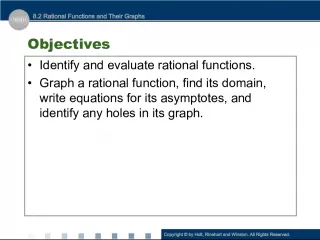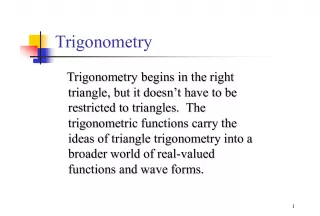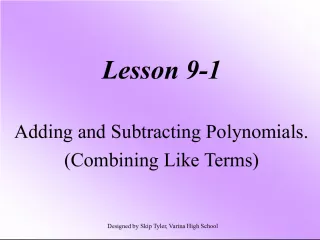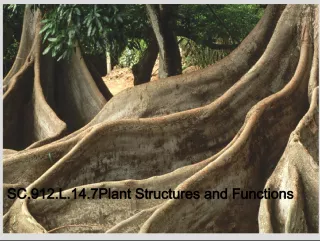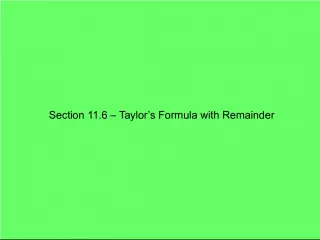"Exploring Rational Functions: Higher Order Polynomials, Asymptotes, and Holes"


In this Algebra 2 GT objective, we will continue our exploration of rational functions, focusing on higher order polynomials, all types
- Uploaded on | 1 Views
-
 beverly
beverly
About "Exploring Rational Functions: Higher Order Polynomials, Asymptotes, and Holes"
PowerPoint presentation about '"Exploring Rational Functions: Higher Order Polynomials, Asymptotes, and Holes"'. This presentation describes the topic on In this Algebra 2 GT objective, we will continue our exploration of rational functions, focusing on higher order polynomials, all types. The key topics included in this slideshow are . Download this presentation absolutely free.
Presentation Transcript
Slide1Wednesday, February 26, 2014 Algebra 2 GT Objective : We will continue to explore rational functions, including higher order polynomials, all types of asymptotes and “holes”. We will work from graph to equation and from equation to graph. Warm Up : 1. What is the similarity between a VA and a hole? What is the difference? 2. How do you use the values of the VA to “build” the equation? 3. How do you use the value of the x-intercept to “build” the equation? 4. How do you solve for the lead coeff. in the equation?
Slide2Weds. 2/26/14 Algebra 2 GTComplete the CW worksheet and Study check out the “coolmath” website http://coolmath.com/algebra/23-graphing-rational- functions/index.html Quiz on 9.3 on Thursday 2/27
Slide3steps for finding key features of a rational function andusing that information to Create the Graph 1. FACTOR both the numerator and denominator, and REDUCE if possible. 2. If a factor remains in the numerator then its root is the x-intercept [ point : (x, 0)] 3. If a factor(s) remains in the denominator then its root is (are) the VA [ equation : x = #] 4. If a factor was canceled then its root is the hole [ point : (x, y) ] 5. Determine HA [ equation : y = #] 6. Find the y-intercept by letting x = 0 in the reduced equation [ point : (0, y)] 7. Graph all of this information and then use your understanding of the behavior of these graphs to sketch. If necessary, you can use some table values to help.
Slide4http://coolmath.com/algebra/23-graphing-rational- functions/index.html
Slide5Determining Horizontal AsymptotesThe value of the H.A. is determined by comparing the highest degree of the numerator with that of the denominator. 1. If numerator > denominator ( top-heavy fraction ), then there is NO H.A . More on this next year. 2. If numerator < denominator ( bottom-heavy fraction ), then the H.A. is ALWAYS at y = 0 . 3. If numerator = denominator ( powers-equal fraction ), then the H.A. is ALWAYS at the line with equation y = a/b , where a and be are the lead coefficients of the num. and denom.
Slide7(0, -1)
Slide9x = -3 y = 5
Slide10We have a new parent function! The RECIPROCAL FUNCTION:
Slide14Can you recreate this graph on yourgraphing calculator?
Slide15Variation Vocabulary …INVERSE Variation – A relationship between variables characterized by the equation DIRECT Variation – A relationship between variables characterized by the equation Constant of Variation – the value of k (also, the slope of a line with y -intercept = 0)
Slide16JOINT Variation – when one quantity varies directly with respect to two or more other quantities. COMBINED Variation involves multiple variations. Some Translations: “ z varies jointly with x and y ” “ z varies jointly with x and y and inversely with the square of w ” “ z varies directly with x and inversely with the product wy ”
Slide17Common Sense understanding of Variation …Direct Variation – as one quantity increases, so does the other, by a constant amount. For example, as the amount of time you drive increases , the distance you drive also increases . The constant of variation is the rate (speed) at which you are driving.
Slide18Common Sense understanding of Variation …Inverse Variation – as one quantity increases, the other decreases. For example, as the outside temperature increases , the amount of time it takes an ice cube to melt decreases .
Slide19Example:A quantity c varies jointly with d and the square of g . Given c = 30 when d = 15 and g = 2 , find k , the constant of variation. Then, find d when c = 6 and g = 8 .
